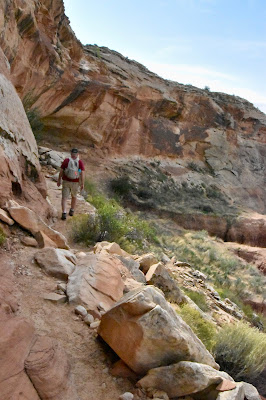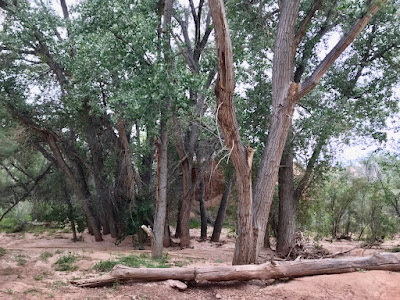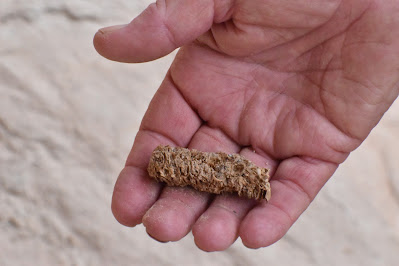A ranch and a river
Once again on a recent balmy morning, we jumped at the opportunity to revisit a stomping ground of old: Del Rio Ranch. Through the efforts of the Chino Valley Historical Society - Kay Lauster, to be exact - we joined a group visiting that historic site. With its once-artesian water and lush grasslands, that quarter of Chino Valley was prime for settlers, and hosted Arizona's first Territorial government prior to those officials moving onto Granite Creek to be closer to the burgeoning population of gold seekers in 1864.
After the departure of Territorial officials, a military contingent, and a newspaper publishing outfit, the place was homesteaded and farmed.
Quite a bit more personally, I wandered those grounds early in my
Yavapai County tenure, and Chris resided in one of the several
residences on the ranch.
An adobe building that is said to have predated the Territorial and military personnel was damaged in a fire and the ruins bulldozed much later. Both Chris & I remember being in that roofless structure and being surprised to see prehistoric pottery shards incorporated into the adobe mud walls.
In this photo, Kay is at the adobe's site and showing photos of the building in its heyday. Oh yes, the señor is getting in his two cents worth.
The remaining structures are nearly all badly deteriorated. Although the property is leased for running cattle, it is for sale and nothing is being done to preserve the buildings, unfortunately. They all date from the days in the early 1900s when the Fred Harvey company maintained a thriving business there for supplying its Grand Canyon and other enterprises with water, produce, dairy products and meat via the railroad line that borders the ranch.
Several of our friends from younger years resided in others of the dwellings at Del Rio. It's one thing to wander through abandoned houses, which we've done many times, but there's something very odd in doing the same in buildings that were a part of our life. The boards and stones of structures derive their life from those within their walls; when they are left alone, they begin a slow decline to collapse as if deprived of breath and blood.
Dave & Sam lived in this big blue house and it was full of energy then. How strange to enter there now and feel its lifelessness.
Some left their mark as they worked to build ditches to move precious water from one pasture to another.
As a group, we walked the two-track that leads to the small Del Rio burying ground, now severely overgrown with huge weeds fed by the summer's monsoons.
Where once there were markers placed to memorialize those they laid to rest there, now one grave only is visible, undoubtedly the other stones taken away by vandals. I photographed that cemetery sometime about 1977, and in a fit of doing what's right, donated the prints to Sharlot Hall Museum. Sad to say, that facility has failed in that bit of preservation; they seem not to be able to retrieve the photos.
. . . I had the opportunity to meet with friends in Camp Verde for a rousing game of mah jong. It just so happened that the señor & I had planned to relocate Wolfie in that vicinity on that particular day. Perfect - he dropped me off for the game (but not before imparting certain words of wisdom and snapping our pic) . . .
. . . and proceeded to take the trailer on to the RV park and set it up in the shade of a giant mesquite tree. . .
. . . a lovely spot at Thousand Trails. Since we stopped there in a previous year, the park has changed in its character quite a bit. A great many of the RVs there are now full-time residences, which does not to my way of thinking improve its stature as a prime RV park. No matter, we did avail ourselves of the nice pool and spa when we weren't getting skunked at fishing.
To be sure, although the score was badly skewed toward the fish, they did not all get away, and this big boy is proof.
One does have to put some effort into getting to the Verde River before one can use that perennial stream for fishing, swimming, kayaking or any of the other pleasurable pursuits that are to be had in that riparian environment.
From our perch, a trail of sorts started off simply enough, for a few yards at least, until it dropped off on what once was likely a nice dirt path, but which has eroded into nothing more than a steep downhill climb over loose river rock. Not terrible, really, as long as one exercises caution, at least until we came to a dropoff that was sheer enough that some before us had installed ladders. One look convinced us that climbing down the rock face was safer than trusting either of those two wooden ladders, so that's what we did.
Over millennia, the river has carved out a wide valley in places. The view across reveals rocky cliffs on both sides towering over flats thick with mesquite, cat claw and other desert vegetation, mostly inhospitable, with the lushness of cottonwoods and willows at the water's edge.
River seekers of the human and animal variety have found ways through the thickets that we utilized by meandering whichever way looked most feasible, backtracking when necessary and winding around in serpentine ways.
Our scramble took us over dried mud flats . . .
That obstruction has backed the river's flow up into a miles-long pool far different than the Verde's more often whitewater rush over rocks. It also transforms that section into more of an environment for catfish and carp than smallmouth bass and trout.
Others who wanted to gain the river bank have hacked away in places at cattails and bamboo to open up bits of shoreline.
Most of the shoreline, though, remains a brushy marshy morass through there.
Though my energy was at a fairly low ebb, I enjoyed being at the Verde, as always, and appreciated the señor encouraging the outing. Certainly grief at the loss of our Darren is affecting my attitude toward life, but knowing that he would want us to savor each moment we are given helps to keep me going.















































































